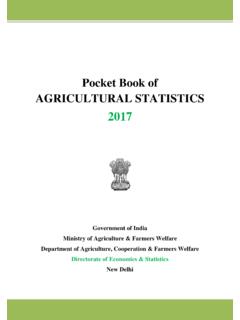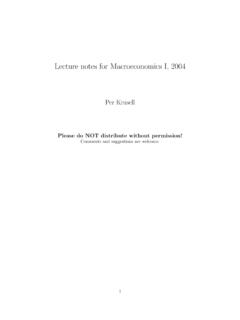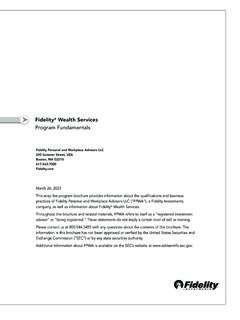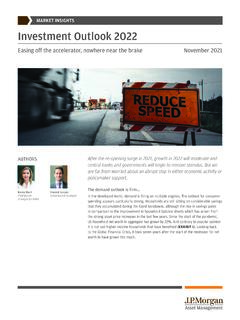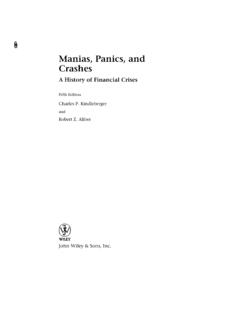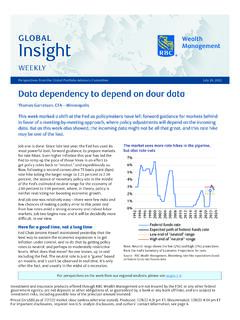Transcription of The importance of Ukraine and the Russian Federation for ...
1 Information Note The importance of Ukraine and the Russian Federation for global agricultural markets and the risks associated with the current conflict 25 March 2022 Update Executive Summary 1. Market structure, trade profiles and recent price trends Market shares The Russian Federation and Ukraine are among the most important producers of agricultural commodities in the world. Both countries are net exporters of agricultural products, and they both play leading supply roles in global markets of foodstuffs and fertilisers, where exportable supplies are often concentrated in a handful of countries. This concentration could expose these markets to increased vulnerability to shocks and volatility.
2 In 2021, either the Russian Federation or Ukraine (or both) ranked amongst the top three global exporters of wheat, maize, rapeseed, sunflower seeds and sunflower oil, while the Russian Federation also stood as the world s top exporter of nitrogen fertilizers, the second leading supplier of potassium fertilizers and the third largest exporter of phosphorous fertilizers. Trade profiles Many countries that are highly dependent on imported foodstuffs and fertilizers, including numerous that fall into the Least Developed Country (LDC) and Low-Income Food-Deficit Country (LIFDC) groups, rely on Ukrainian and Russian food supplies to meet their consumption needs.
3 Many of these countries, already prior to the conflict, had been grappling with the negative effects of high international food and fertilizer prices. 2. Risk analysis: Assessing the risks emanating from the conflict Trade risks In Ukraine , the escalation of the conflict raises concerns on whether crops will be harvested and products exported. The war has already led to port closures, the suspension of oilseed crushing operations and the introduction of export licensing requirements for some products. All of these could take a toll on the country s exports of grains and vegetable oils in the months ahead.
4 Much uncertainty also surrounds Russian export prospects, given sales difficulties that may arise as a result of economic sanctions imposed on the country. Price risks FAO s simulations gauging the potential impacts of a sudden and steep reduction in grain and sunflower seed exports by the two countries indicate that these shortfalls might only be partially compensated by alternative sources during the 2022/23 marketing season. The capacity of many exporting countries to boost output and 2 shipments may be limited by high production and input costs. Worryingly, the resulting global supply gap could raise international food and feed prices by 8 to 22 percent above their already elevated baseline levels.
5 If the conflict keeps crude oil prices at high levels and prolongs the two countries reduced global export participation beyond the 2022/23 season, a considerable supply gap would remain in global grain and sunflowerseed markets, even as alternative producing countries expand their output in response to the higher output prices. This would keep international prices elevated well above baseline levels. Logistical risks In Ukraine , there are also concerns that the conflict may result in damages to inland transport infrastructure and seaports, as well as storage and processing infrastructure. This is all the more so given the limited capacity of alternatives, such as rail transport for seaports or smaller processing facilities for modern oilseeds crushing facilities, to compensate for their lack of operation.
6 More generally, apprehensions also exist regarding increasing insurance premia for vessels destined to berth in the Black Sea region, as these could exacerbate the already elevated costs of maritime transportation, compounding further the effects on the final costs of internationally sourced food paid by importers. Production risks Although early production prospects for 2022/23 winter crops were favourable in both Ukraine and the Russian Federation , in Ukraine , the conflict may prevent farmers from attending to their fields and harvesting and marketing their crops, while disruptions to essential public services could also negatively affect agricultural activities.
7 Current indications are that, as a result of the conflict, between 20 and 30 percent of areas sown to winter crops in Ukraine will remain unharvested during the 2022/23 season, with the yields of these crops also likely to be adversely affected. Furthermore, considerable uncertainties surround Ukrainian farmers capacity to plant crops during the fast approaching spring crop cycle. The conflict is also likely to affect the ability of Ukraine to control its animal disease burden, significantly increasing the risk of proliferation of animal diseases, notably of African swine fever (ASF), within Ukraine and in neighbouring countries.
8 In the case of the Russian Federation , although no major disruption to crops already in the ground appears imminent, uncertainties exist over the impact that the international sanctions imposed on the country will have on food exports. Any loss of export markets could depress farmer incomes, thereby negatively affecting future planting decisions. economic sanctions imposed on the Russian Federation could also disrupt its imports of agricultural inputs, notably pesticides and seeds, on which the country is highly dependent. This could result in less plantings, lower yields and lower qualities, exposing the Russian agricultural sector and global food supplies, at large, to non-negligible risks.
9 Humanitarian risks The conflict is set to increase humanitarian needs in Ukraine , while deepening those of millions of people that prior to its escalation were already displaced or requiring assistance due to the more than eight-year conflict in the eastern part of the country. By directly constraining agricultural production, limiting economic activity and raising prices, the conflict will further undercut the purchasing power of local populations, with consequent increases in food insecurity and malnutrition. 3 Humanitarian needs in neighbouring countries, where displaced populations are seeking refuge, are also set to increase substantially.
10 Globally, if the conflict results in a sudden and prolonged reduction in food exports by Ukraine and the Russian Federation , it will exert additional upward pressure on international food commodity prices to the detriment of economically vulnerable countries, in particular. FAO s simulations suggest that under such a scenario, the global number of undernourished people could increase by 8 to 13 million people in 2022/23, with the most pronounced increases taking place in Asia-Pacific, followed by sub-Saharan Africa, and the Near East and North Africa. If the war lasts, impacts will go well beyond 2022/23. Energy risks The Russian Federation is a key player in the global energy market.










